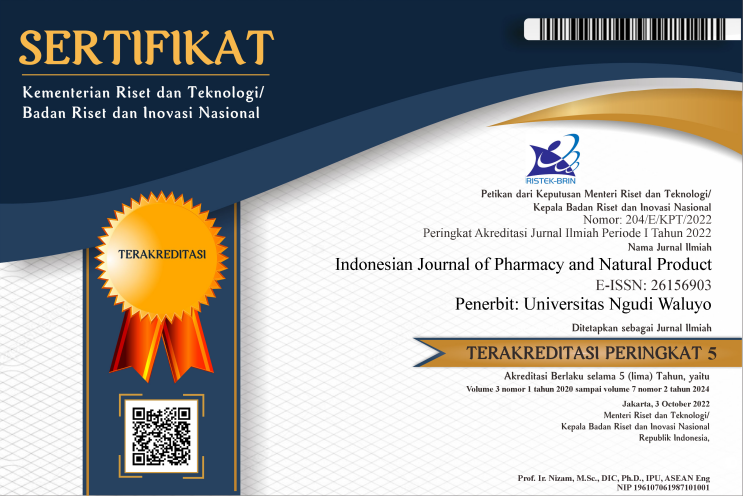Studi In Silico Analog Heksagamavunon-6 Sebagai Anti-Helicobacter Pylori
DOI:
https://doi.org/10.35473/ijpnp.v3i2.554Abstract
ABSTRAK
Infeksi Helicobacter pylori (H. pylori) menyebabkan timbulnya berbagai masalah pada saluran cerna, seperti gastritis kronik, peptic ulcer, gastric mucosa-associated lymphoid tissue (MALT) hingga menimbulkan kanker. Resisten terhadap antibiotik terus mengalami peningkatan menuntut segera ditemukannya pengobatan baru yang efektif. Penelitian ini bertujuan untuk mengevaluasi potensi senyawa Heksagamavunon-6 (HGV-6) dan analognya (D144, D154, dan D156) sebagai anti-H.pylori. Program AutoDock Vina digunakan pada proses penambatan molekul. Ligan uji, HGV-6 dan analognya, ditambatkan pada enzim shikimat kinase (PDB ID: 3N2E) dan urease (PDB ID: 1E9Y) sebagai target kerja dalam menghambat bakteri H.pylori. Parameter yang diamati berupa energi ikatan (kkal/mol) antara ligan uji dan protein dibandingkan dengan energi ikatan antara ligan asli dengan protein. Hasil penambatan pada enzim shikimat kinase menunjukkan bahwa energi ikatan senyawa HGV-6 (-9,2) dan D156 (-8,8) lebih rendah dibandingkan dengan energi ikatan ligan asli (-8,7), sedangkan D144 (-8,0 ) dan D154 (-8,4 ) memiliki energi ikatan yang lebih tinggi. Nilai energi ikatan antara enzim urease dengan HGV-6 (-7.7), D156 (-7,7), D154 (-6,7) dan D144 (-6,7) lebih rendah dibandingkan dengan energi ikatan enzim urease dengan ligan asli (-3,5). HGV-6 dan D156 memiliki potensi sebagai anti- H.pylori lebih tinggi dibandingkan analog lainnya. Penelitian lebih lanjut secara in vitro perlu dilakukan untuk mengevaluasi potensi HGV6 dan analognya sebagai anti- H.Pylori.
Kata kunci : Shikimat kinase, Urease, HGV-6, H. pylori, docking molekul, AutoDock Vina
Helicobacter pylori (H. pylori) infections cause various gastrointestinal problems, such as chronic gastritis, peptic ulcer, gastric mucosa-associated lymphoid tissue (MALT) and cancer. Antibiotic resistance continues to increase, demanding that new effective treatments found immediately. This study aim was to evaluate the potential of the hexagamavunon-6 (HGV-6) compound and its analogues (D144, D154, and D156) as anti-H. pylori. AutoDock Vina program was used for molecular docking. The ligand, HGV-6 and its analogues, was docked to the enzyme shikimate kinase (PDB ID: 3N2E) and urease (PDB ID: 1E9Y) as a target of action to inhibit H. pylori bacteria. The parameter observed was the binding energy (kcal/mol) between the ligand and protein compared with the binding energy between the native ligand with protein. The results of docking protocol to the shikimate kinase enzyme showed that the binding energy of HGV-6 (-9.2) and D156 (-8.8) are lower than native ligand binding energy (-8.7), whereas D144 (-8.0) ) and D154 (-8.4) have higher binding energy. The binding energy values between the urease enzyme and HGV-6 (-7.7), D156 (-7.7), D154 (-6.7) and D144 (-6.7) are lower than the binding energy of the urease enzyme with the native ligand ( -3.5). HGV-6 and D156 have higher anti-H.pylori potential than others. Further in vitro research needs to be carried out to evaluate the potential of HGV6 and its analogues as anti-H. pylori.Keywords: Shikimate kinase, Urease, HGV-6, H. pylori, molecular docking, AutoDock Vina
References
Benet, L.Z., Hosey, C.M., Ursu, O., dan Oprea, T.I., 2016. BDDCS, the Rule of 5 and drugability. Advanced Drug Delivery Reviews, 101: 89–98.
Burkitt, M.D., Duckworth, C.A., Williams, J.M., dan Pritchard, D.M., 2017. Helicobacter pylori-induced gastric pathology: insights from in vivo and ex vivo models. Disease Models & Mechanisms, 10: 89–104.
Cheng, W.-C., Chang, Y.-N., dan Wang, W.-C., 2005. Structural Basis for Shikimate-Binding Specificity of Helicobacter pylori Shikimate Kinase. Journal of Bacteriology, 187: 8156–8163.
Chey, W.D., Leontiadis, G.I., Howden, C.W., dan Moss, S.F., 2017. ACG clinical guideline: treatment of Helicobacter pylori infection. American Journal of Gastroenterology, 112: 212–239.
Debraekeleer, A. dan Remaut, H., 2018. Future perspective for potential Helicobacter pylori eradication therapies. Future Microbiology, 13: 671–687.
Diaconu, S., Predescu, A., Moldoveanu, A., Pop, C.S., dan Fierbințeanu-Braticevici, C., 2017. Helicobacter pylori infection: old and new. Journal of medicine and life, 10: 112.
Francenia Santos-Sánchez, N., Salas-Coronado, R., Hernández-Carlos, B., dan Villanueva-Cañongo, C., 2019. Shikimic Acid Pathway in Biosynthesis of Phenolic Compounds, dalam: Soto-Hernández, M., GarcÃa-Mateos, R., dan Palma-Tenango, M. (Editor), Plant Physiological Aspects of Phenolic Compounds. IntechOpen.
Gupta, S.C., Prasad, S., Kim, J.H., Patchva, S., Webb, L.J., Priyadarsini, I.K., dkk., 2011. Multitargeting by curcumin as revealed by molecular interaction studies. Natural Product Reports, 28: 1937.
Han, C., Zhang, J., Chen, L., Chen, K., Shen, X., dan Jiang, H., 2007. Discovery of Helicobacter pylori shikimate kinase inhibitors: Bioassay and molecular modeling. Bioorganic & Medicinal Chemistry, 15: 656–662.
Hernndez-Santoyo, A., Yair, A., Altuzar, V., Vivanco-Cid, H., dan Mendoza-Barrer, C., 2013. Protein-Protein and Protein-Ligand Docking, dalam: Ogawa, T. (Editor), Protein Engineering - Technology and Application. InTech.
Hevener, K.E., Zhao, W., Ball, D.M., Babaoglu, K., Qi, J., White, S.W., dkk., 2009. Validation of molecular docking programs for virtual screening against dihydropteroate synthase. Journal of chemical information and modeling, 49: 444–460.
Idrees, S. dan Ashfaq, U.A., 2014. Discovery nd design of cyclic peptides as dengue virus inhibitors through structure-besed molecular docking. Asian Pacific Journal of Tropical Medicine, 7: 513–516.
Istyastono, E.P., 2009. Docking studies of curcumin as a potential lead compound to develop novel dipeptydyl peptidase-4 inhibitors. Indonesian Journal of Chemistry, 9: 132–136.
Kaladhar, D., Banjara, T., Kant, S., Mishra, S.T., dan Dupplala, S.K., 2018. In Silico Screening of Compounds from Turmeric (Curcuma Longa L.) against Cancer Causing Proteins. International Journal of Current Trends in Engineering & Technology, 04: 11–18.
Kusters, J.G., Vliet, A.H.M. van, dan Kuipers, E.J., 2006. Pathogenesis of Helicobacter pylori Infection. Clinical Microbiology Reviews, 19: 449–490.
Li, S., Yuan, W., Deng, G., Wang, P., Yang, P., dan Aggarwal, B., 2011. Chemical composition and product quality control of turmeric (Curcuma longa L.). Pharmaceutical Crops, 2: 28–54.
Lipinski, C.A., 2004. Lead- and drug-like compounds: the rule-of-five revolution. Drug Discovery Today: Technologies, 1: 337–341.
Mehvish, S., Betty, D., dan K, M., 2011. Antimicrobial Activity of Three Different Rhizomes of Curcuma Longa & Curcuma Aromatica on Uropathogens of Diabetic Patients. International Journal of Pharmacy & Pharmaceutical Sciences, 3: 273.
Noviardi, H. dan Fachrurrazie, F., 2015. Potensi Senyawa Bullatalisin Sebagai Inhibitor Protein Leukotrien A4 Hidrolase Pada Kanker Kolon Secara In Silico. FITOFARMAKA: Jurnal Ilmiah Farmasi, 5: 65–73.
Peng, C., Hu, Y., Ge, Z.-M., Zou, Q.-M., dan Lyu, N.-H., 2019. Diagnosis and treatment of Helicobacter pylori infections in children and elderly populations. Chronic Diseases and Translational Medicine, 5: 243–251.
Sarkar, A., De, R., dan Mukhopadhyay, A.K., 2016. Curcumin as a potential therapeutic candidate for Helicobacter pylori associated diseases. World Journal of Gastroenterology, 22: 2736.
Tambunan, U.S.F. dan Alamudi, S., 2010. Designing cyclic peptide inhibitor of dengue virus NS3-NS2B protease by using molecular docking approach. Bioinformation, 5: 250.
Vetvicka, V., Vetvickova, J., dan Fernandez-Botran, R., 2016. Effects of curcumin on Helicobacter pylori infection. Annals of Translational Medicine, 4: 479–479.
Vijesh, A.M., Isloor, A.M., Telkar, S., Peethambar, S.K., Rai, S., dan Isloor, N., 2011. Synthesis, characterization and antimicrobial studies of some new pyrazole incorporated imidazole derivatives. European Journal of Medicinal Chemistry, 46: 3531–3536.
Wardani, A.K., Ritmaleni, dan Setyowati, E.P., 2020. Molecular Docking Studies OF HGV-6 Analogue as a Potential PBP-1A Inhibitor. International Journal of Pharmacy and Pharmaceutical Sciences, 12: 32–36.
Yuniarti, N., Nugroho, P.A., Asyhar, A., Sardjiman, S., Ikawati, Z., dan Istyastono, E.P., 2012. In vitro and In Silico Studies on Curcumin and Its Analogues as Dual Inhibitors for cyclooxygenase-1 (COX-1) and cyclooxygenase-2 (COX-2). ITB Journal of Sciences, 44: 51–66.



